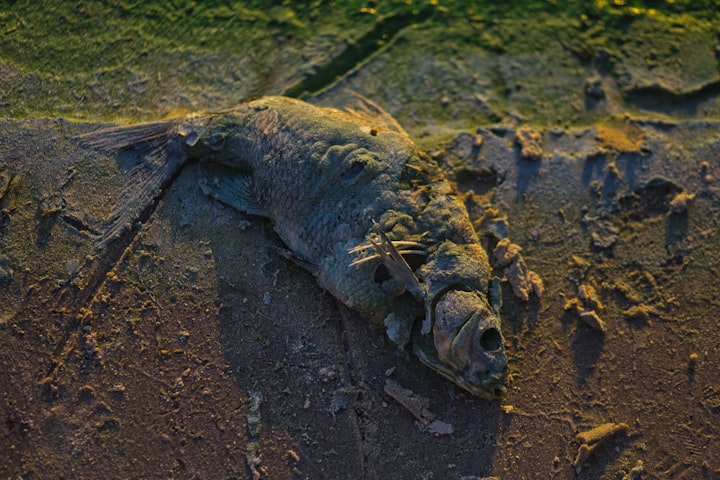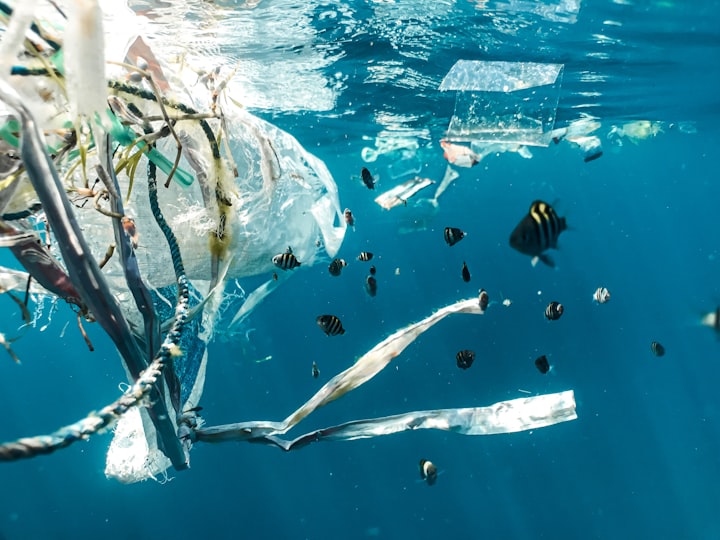Fish Kill Cover-Up
No Blue=No Green

This story is the tenth installment of a Vocal creators collaborative calling attention to a crisis facing the entire planet-plastics in the ocean.
Here is the previous story, The Tale of Eco The Dolphin by Josephine Mason.
While the following story is an extrapolated, fictionalized account, the science is very real. The sources I used are listed at the end of this story.
Today is August 25, 2055. My 75th birthday. These days, I live a quiet, self-sufficient life in the mountains of Upstate New York. Life has become difficult for many across the planet, and even though scientists predicted the oceans would be void of any substantial life by 2068, the oceans are already dead.
By the time the government acknowledged that there was a problem, it was too late. A chain reaction had been started decades before and was covered up by multiple government agencies for a decade. NOAA Fisheries, the EPA, the FDA, USDA, and the CDC were all involved. It didn’t become public knowledge until a group of like-minded scientists came forward. One of those scientists was me. And here is how it really happened.
After the five-year pandemic, there was a renewed, multinational response to clean up the Pacific garbage patch. Part of the clean-up included studies on the effects of plastics and microplastics on fish. NOAA fisheries headed this up, and I was one of the marine biologists taking part in the study. Around the same time, fish kills were occurring all over the world, but mainly on the Pacific coasts of the United States and Mexico, and across the Pacific, the coasts of Japan and the Philippines. In every single dead fish we randomly tested, the cause of death was suffocation due to microplastics. They get caught in the gills of fish and prevents them from breathing. The fish also had high levels of BPA, or Bisphenol A, a chemical used in plastic production

It wasn’t just the fish kills that were concerning. Fishermen throughout the world were noting smaller harvests. They reported that they had to go further and further out, and the fishing season just wasn’t long enough to keep up with demand. In 2025, NOAA Fisheries, which regulates and tracks the fish population, noted that fish were not reproducing enough to maintain the population.
In the summer of 2026, the population of seals on the west coast began to decline. Testing on the dead seals revealed high levels of BPA in their blood and tissue. Autopsies conducted found an abnormal level of cancers, mainly affecting the endocrine system in these animals. The seals were not reproducing either. With the fish population decreasing and the testing results we reported, the USDA Fish and Wildlife Services became involved. They discovered microplastics and high levels of BPA in every animal they tested. Every animal in the ocean’s ecosystem was being affected.
The FDA was still insisting that while BPA levels in seafood products have increased, the level is still within the range for safe human consumption. They were wrong.
In 2028, scientific studies showed that the shark population was decreasing at an alarming rate, and they were traveling further north, creating an alarming rate of human and shark encounters. Most beaches on the west coast were no longer safe to swim and recreate in. Algae blooms became more and more widespread. Whales, dolphins, and sharks were washing up on shores worldwide. The decreasing fish population was starving marine animals. Autopsies conducted on dead animals all showed the same microplastics, cancers, and reproductive issues, and most of them were malnourished.
By 2032, polar bears were extinct in the wild, and the penguin population throughout the world decreased so rapidly that several were put on the endangered species list. Fisheries were closing at an increased rate, and by the end of 2033, the supply of seafood was less than the demand, so prices skyrocketed. This collapsed the seafood market across the world. Other world agencies were sounding the alarm about levels of BPA and microplastics. The FDA still maintained their company line.
In 2035, the CDC was investigating cancer clusters in communities along the west coast and island nations in south Asia. They directly related the cancer clusters to BPA levels in not just the fish, but also in the ocean. The pollution that was collapsing the ocean’s ecosystem was now harming humans. And they stayed quiet about it. It wasn’t long before some scientists across the different government agencies involved decided it was time to expose the government cover-up. I was one of them. We drafted a letter, attached some reports and summaries of our findings, and sent them to major news outlets. Our careers were destroyed. Most of us were immediately terminated. But now, the public knew what scientists and government organizations had been hiding for a decade.
There were government investigations wrapped up in bureaucratic red tape. The scientists who went public were not involved, even though we were the ones sounding the alarm. We were, however, called to testify at Senate hearings in 2037. A senator asked one of my colleagues what could be done to stop the crisis.
“Senator, with all due respect, there is nothing we can do. We are well into a chain reaction that cannot be stopped. Plastic pollution from landfills makes it to the ocean via rivers and waterways. Plastic degrades, releasing more and more BPA, and creating microplastics. This has been going on for decades, to the point where there is no way to remove the microplastics from the ocean or the ocean’s marine life. When the fish kills started, it was too late to turn the tide. At present, there is more plastic in the ocean than fish and wildlife, which wasn’t predicted to be until 2050. We are now in a mass extinction event, and this was all started by plastic pollution in our oceans. For years, bureaucrats within the NOAA Fisheries, USDA, FDA, and the EPA denied and ignored our results and findings, and now humans are dying because of it. The rapid loss of fish affected everything above them in the food chain, including humans. Hundreds of animals are now extinct. Sixty percent of ocean life is gone. And as the plastic degrades, it will continue to release BPA. Before long, the world’s oceans will be unsafe for humans.”
The senator’s response: “May our children and grandchildren forgive us.”
By the end of 2037, the FDA reversed its course on the safety levels of BPA; only it was too late. BPA and microplastics, by that point, were showing up in land animals as well. The USDA banned all seafood from the ocean. The EPA banned BPA use. NOAA fisheries lost their funding, and the CDC started massive research into cancers caused by BPA. Aside from cancer, the CDC reported reproductive problems and endocrine problems stemming from the BPA we have all been exposed to for decades
By 2045, most whales and sea mammals outside of captivity had become extinct.
By 2050, over ninety percent of oceanic wildlife was gone.
The oceans have become acidic and non-oxygenated. Sea fairing communities disappeared as people moved inland.
No one really knows what time has in store for humanity. To date, it is estimated that around four million people have died from cancers caused by BPA, but that number is undoubtedly much higher. It would seem that losing the oceans is leading to humanity’s extinction.
I remember I worked with another scientist. Her name was Courtney, and she was so passionate about this work. She had a bumper sticker on her car. It simply read, “No Blue=No Green”. How prophetic that bumper sticker was.
For more information on microplastic pollution and a ten-step plan:
By 2050 there may be more plastic than fish in the sea. This 10-step plan can change that
Sources:
What is BPA, and What are the Concerns about BPA, Mayo Clinic
BPA and the Controversy About Plastic Food Containers, Poison Control
What to Know About Plastics in Seafood, Medical News Today
Next up in this collaboration is the final story by Courtney Capone.
About the Creator
J. Delaney-Howe
Bipolar poet. Father. Grandfather. Husband. Gay man. I write poetry, prose, some fiction and a good bit about family. Thank you for stopping by.
Queer Vocal Voices on Facebook.
Find me on Facebook.






Comments
There are no comments for this story
Be the first to respond and start the conversation.